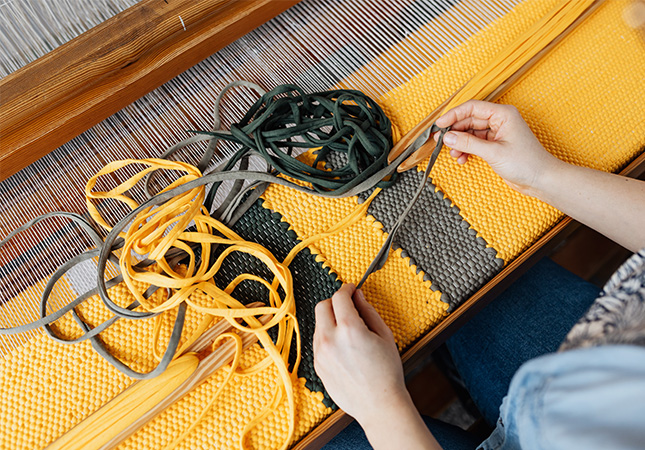Different weaving patterns can be achieved by varying the warp and weft threads on a weaving machine. The most common weaving is the plain weaving, in which the warp and weft threads cross over and under each other alternately. Other popular weave patterns include the twill weave, in which the threads are woven in a diagonal pattern on a weaving machine, and the satin weave, in which the threads are woven in a smooth, lustrous finish.

Warp threading is the process of setting the warp yarns onto the loom before weaving can begin. The warp yarns are arranged in a specific order according to the design of the fabric that is to be woven. This process can be done by hand or by machine.
Hand-warping is a slow process and is only used for small-scale production. The weaver must thread each warp yarn through the heddles and reed, following the pattern that has been set out. This process can be very tedious, especially if there are a lot of warp yarns to be threaded.
Machine warping is a much faster process and is used for large-scale production. The warp yarns are fed through a series of rollers and then into the heddles and reed. This process is automated, so it is much less likely that errors will be made during the warping process.
Warping the Loom
Different types of fabrics require different textile preprocessing methods to achieve the desired final product. In some cases, the fabric may need to be warped before it can be used on a loom. Warping is the process of winding yarn or thread onto a beam or frame called a warp, which is then used to weave fabric on a loom.
Warping fabric is a necessary step in the textile preprocessing methods of many types of fabric, including but not limited to: linen, cotton, wool, silk, and synthetic fabrics. The type of yarn being used, as well as the desired width and length of the fabric, will dictate the specific warping method that needs to be used.
There are 4 main methods of warping fabric: hand-winding, direct warping, indirect warping, and sectional warping. Hand-winding is the simplest method and can be done with any type of yarn. Direct warping is typically used for long pieces of fabric and is faster than hand-winding or indirect warping. Indirect warping is often used for shorter lengths of fabric and gives more control over the placement of warp threads than direct warping. Sectional warping is performed in sections and is typically used for very long lengths of fabric or when special effects are desired.
Once the warp has been created, it must be attached to the loom so that weaving can begin. The specific method used to attach the warp
Weft Threading
Weft threading is a textile preprocessing method in which the weft yarns are inserted into the fabric before weaving, which consists of 2 main parts: the needle bed and the shuttle box. The needle bed holds the needles that are used to insert the weft yarns into the fabric. The shuttle box contains the shuttles that hold the weft yarns.
The weft-threading machine is operated by an operator who controls the needle bed and shuttle box. The operator first threads the weft yarns through the needle bed. Then, they pass the weft yarns through the eyes of the needles on the needle bed. After that, they thread the weft yarns through the shuttles on the shuttle box. Finally, they weave the fabric using the weft threads.
Woven fabrics are made by interlacing 2 sets of yarns at right angles to each other. The lengthwise yarns are called the warp, and the crosswise yarns are called the weft. Woven fabrics can be made from a variety of fibers, including cotton, linen, wool, silk, and synthetics.
Knit fabrics are made by interlocking loops of yarn. They can be made from a variety of fibers, including cotton, wool, and synthetics. Knit fabrics have a stretchy quality that makes them ideal for garments such as sweaters and t-shirts.
Non-woven fabrics are made from individual fibers that have been bonded together using chemical or mechanical processes. Non-woven fabrics are often used in applications where strength and absorbency are important, such as in medical products or packaging materials.




